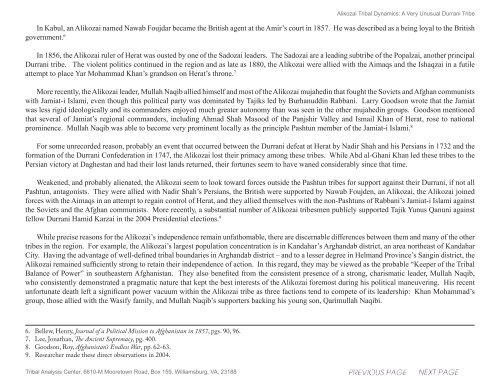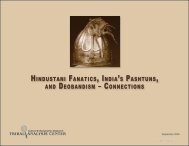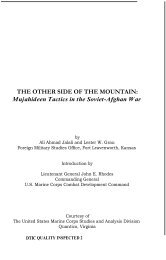ALIKOZAI TRIBAL DYNAMICS: A VERY UNUSUAL DURRANI TRIBE
ALIKOZAI TRIBAL DYNAMICS: A VERY UNUSUAL DURRANI TRIBE
ALIKOZAI TRIBAL DYNAMICS: A VERY UNUSUAL DURRANI TRIBE
Create successful ePaper yourself
Turn your PDF publications into a flip-book with our unique Google optimized e-Paper software.
Alikozai Tribal Dynamics: A Very Unusual Durrani Tribe<br />
In Kabul, an Alikozai named Nawab Foujdar became the British agent at the Amir’s court in 1857. He was described as a being loyal to the British<br />
government. 6<br />
In 1856, the Alikozai ruler of Herat was ousted by one of the Sadozai leaders. The Sadozai are a leading subtribe of the Popalzai, another principal<br />
Durrani tribe. The violent politics continued in the region and as late as 1880, the Alikozai were allied with the Aimaqs and the Ishaqzai in a futile<br />
attempt to place Yar Mohammad Khan’s grandson on Herat’s throne. 7<br />
More recently, the Alikozai leader, Mullah Naqib allied himself and most of the Alikozai mujahedin that fought the Soviets and Afghan communists<br />
with Jamiat-i Islami, even though this political party was dominated by Tajiks led by Burhanuddin Rabbani. Larry Goodson wrote that the Jamiat<br />
was less rigid ideologically and its commanders enjoyed much greater autonomy than was seen in the other mujahedin groups. Goodson mentioned<br />
that several of Jamiat’s regional commanders, including Ahmad Shah Masood of the Panjshir Valley and Ismail Khan of Herat, rose to national<br />
prominence. Mullah Naqib was able to become very prominent locally as the principle Pashtun member of the Jamiat-i Islami. 8<br />
For some unrecorded reason, probably an event that occurred between the Durrani defeat at Herat by Nadir Shah and his Persians in 1732 and the<br />
formation of the Durrani Confederation in 1747, the Alikozai lost their primacy among these tribes. While Abd al-Ghani Khan led these tribes to the<br />
Persian victory at Daghestan and had their lost lands returned, their fortunes seem to have waned considerably since that time.<br />
Weakened, and probably alienated, the Alikozai seem to look toward forces outside the Pashtun tribes for support against their Durrani, if not all<br />
Pashtun, antagonists. They were allied with Nadir Shah’s Persians, the British were supported by Nawab Foujden, an Alikozai, the Alikozai joined<br />
forces with the Aimaqs in an attempt to regain control of Herat, and they allied themselves with the non-Pashtuns of Rabbani’s Jamiat-i Islami against<br />
the Soviets and the Afghan communists. More recently, a substantial number of Alikozai tribesmen publicly supported Tajik Yunus Qanuni against<br />
fellow Durrani Hamid Karzai in the 2004 Presidential elections. 9<br />
While precise reasons for the Alikozai’s independence remain unfathomable, there are discernable differences between them and many of the other<br />
tribes in the region. For example, the Alikozai’s largest population concentration is in Kandahar’s Arghandab district, an area northeast of Kandahar<br />
City. Having the advantage of well-defined tribal boundaries in Arghandab district – and to a lesser degree in Helmand Province’s Sangin district, the<br />
Alikozai remained sufficiently strong to retain their independence of action. In this regard, they may be viewed as the probable “Keeper of the Tribal<br />
Balance of Power” in southeastern Afghanistan. They also benefited from the consistent presence of a strong, charismatic leader, Mullah Naqib,<br />
who consistently demonstrated a pragmatic nature that kept the best interests of the Alikozai foremost during his political maneuvering. His recent<br />
unfortunate death left a significant power vacuum within the Alikozai tribe as three factions tend to compete of its leadership: Khan Mohammad’s<br />
group, those allied with the Wasify family, and Mullah Naqib’s supporters backing his young son, Qarimullah Naqibi.<br />
6. Bellew, Henry, Journal of a Political Mission to Afghanistan in 1857, pgs. 90, 96.<br />
7. Lee, Jonathan, The Ancient Supremacy, pg. 400.<br />
8. Goodson, Roy, Afghanistan’s Endless War, pp. 62-63.<br />
9. Researcher made these direct observations in 2004.<br />
Tribal Analysis Center, 6610-M Mooretown Road, Box 159. Williamsburg, VA, 23188
















